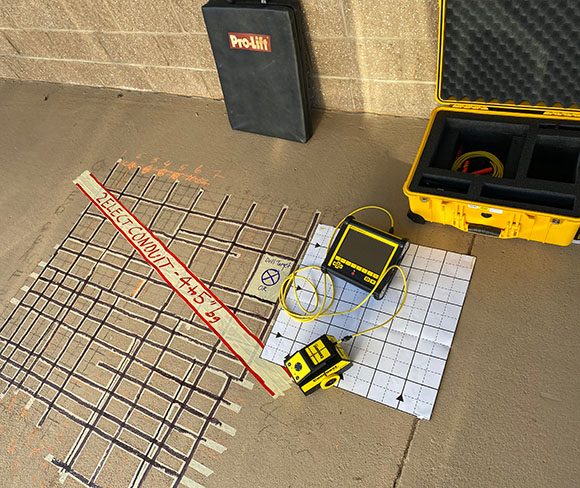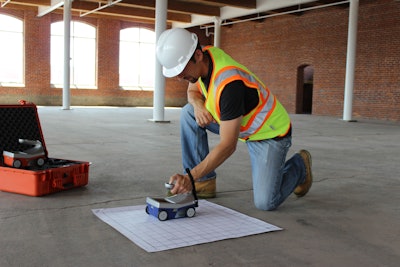Beyond the Surface Area: Leveraging Advanced Concrete Scanning Techniques for Unmatched Precision and Insight
Advanced concrete scanning methods have emerged as crucial tools in this search, using a peek below the surface area to introduce a globe of critical understandings. By harnessing sophisticated technologies, experts can discover anomalies, examine the condition of concrete structures, and make notified choices that form the course of jobs.
Value of Advanced Concrete Scanning
The significance of utilizing advanced concrete scanning methods depends on the unrivaled accuracy they use for detecting sub-surface anomalies and guaranteeing architectural honesty. By employing advanced technologies such as ground-penetrating radar (GPR), electro-magnetic induction, and advanced finder imaging, building experts can delve below the surface of concrete frameworks with a level of accuracy that much goes beyond typical evaluation methods. Concrete Scanning. These strategies make it possible for the identification of covert hazards like rebar rust, voids, conduits, or post-tension cable televisions that might compromise the security and security of a structure over time
Furthermore, progressed concrete scanning offers invaluable understandings into the general problem of a concrete element without the requirement for intrusive measures, minimizing the threat of causing damage throughout the analysis procedure. The ability to pinpoint the exact area and deepness of prospective problems enables targeted repair services and upkeep, ultimately prolonging the lifespan of the framework and maximizing its performance. In essence, the value of advanced concrete scanning can not be overemphasized in the realm of building and construction and infrastructure upkeep, where accuracy and integrity are extremely important.
Kinds of Cutting-Edge Technologies

Anomalies and Issue Discovery

In addition to GPR, concrete scanning techniques like thermography and why not find out more impact-echo screening are also reliable in spotting abnormalities and flaws. By leveraging these sophisticated techniques, specialists can proactively deal with architectural concerns, making certain the durability and safety of concrete structures.
Assessing Concrete Condition
Just how can designers properly examine the condition of concrete structures to ensure their long life and security? Analyzing the concrete condition is an essential element of keeping framework stability. Different advanced concrete scanning strategies are used for this purpose. Ground-penetrating radar (GPR) is frequently used to examine the internal framework of concrete, discovering voids, splits, and various other anomalies that may compromise its strength. Furthermore, impact-echo screening can offer insights right into the thickness and stability of concrete components. Ultrasonic pulse velocity testing is an additional important approach for reviewing concrete quality by gauging the rate of audio waves via the product.
Furthermore, visual inspection stays an click over here essential part of concrete problem analysis. Designers aesthetically take a look at the surface for indications of damage, such as spalling, fracturing, or discoloration. Incorporating non-destructive testing techniques with aesthetic assessments permits an extensive assessment of concrete condition, allowing engineers to recognize prospective problems beforehand and execute timely upkeep or fixings. By leveraging these sophisticated methods, engineers can make sure the long-lasting durability and safety and security of concrete frameworks.
Enhancing Decision-Making Procedures
In the world of facilities monitoring, optimizing decision-making processes is imperative for ensuring the reliable maintenance and longevity of concrete structures. Boosted decision-making processes in concrete monitoring include making use of innovative scanning methods to gather in-depth information on the condition of structures. By leveraging technologies such as ground-penetrating radar and 3D imaging, stakeholders can make educated decisions pertaining to repair work, substitute, or reinforcement strategies.
These progressed scanning methods provide vital insights into the interior structure of concrete, determining prospective issues such as voids, cracks, or corrosion that might not be visible externally. This degree of detailed information allows for proactive upkeep preparation, lessening the danger of architectural failings and increasing the general life expectancy of concrete frameworks.
Furthermore, by integrating electronic paperwork and analysis devices right into the decision-making procedure, stakeholders can track the development of concrete problems gradually, making it possible for Visit Your URL predictive maintenance methods and enhancing resource appropriation. Ultimately, the assimilation of sophisticated concrete scanning techniques boosts decision-making processes by supplying unrivaled accuracy, insight, and performance in facilities administration.
Conclusion
In final thought, progressed concrete scanning strategies use unrivaled precision and understanding in spotting abnormalities, defects, and examining the condition of concrete structures. By leveraging sophisticated technologies, decision-making procedures can be boosted, resulting in even more reliable and educated solutions for keeping and repairing concrete framework. These techniques play an important function in ensuring the safety and security and long life of concrete frameworks, making them a vital tool in the field of building and construction and design.
In addition, progressed concrete scanning supplies vital insights into the overall problem of a concrete aspect without the demand for invasive steps, decreasing the threat of triggering damage throughout the evaluation procedure - Concrete Scanning. Another cutting-edge innovation is 3D X-ray scanning, which offers comprehensive images of the internal framework of concrete, providing beneficial details without the requirement for devastating screening. Additionally, Concrete Cover Meters are utilized to determine the density of concrete cover over reinforcement bars properly. Enhanced decision-making procedures in concrete monitoring entail making use of sophisticated scanning techniques to collect in-depth information on the problem of frameworks.In final thought, progressed concrete scanning methods supply unmatched accuracy and insight in detecting abnormalities, problems, and analyzing the condition of concrete structures